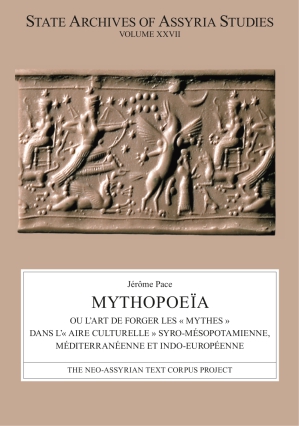
Mythopoeïa
ou l’art de forger les « mythes » dans l’« aire culturelle » syro-mésopotamienne, méditerranéenne et indo-européenne
Jérôme Pace
Mythopoeïa
ou l’art de forger les « mythes » dans l’« aire culturelle » syro-mésopotamienne, méditerranéenne et indo-européenne
Jérôme Pace
Objet d'étude fascinant mais difficile d'appréhension, le mythe définit les visions du monde et les identités des sociétés anciennes. Présentant une analyse comparée de nombreux thèmes mythologiques, comme le dieu de l'orage, le jeune héros, le chaos, le combat contre le monstre, la royauté, le jugement final, l’organisation du cosmos, et la fondation du royaume, cet ouvrage novateur, et d'une vertigineuse érudition, interroge l’existence possible d’une aire culturelle mythologique—« mythopoïétique »—indo-méditerranéenne.
- Description
- Bio
- Table of Contents
- Subjects
Religious and historical myths defined the worldviews and identities of ancient societies and form a fascinating, but difficult, object of study. In presenting a comparative analysis of several interrelated ancient mythical themes, such as the storm god, the young hero, chaos, combat with monsters, kingship, final judgment, organization of the cosmos, and the foundation of kingship, this thorough and groundbreaking study explores the possibility of a mythological—or “mythopoeic”—Indo-Mediterranean cultural space.
Jérôme Pace is a religious studies scholar who specializes in myths.
PRÉFACE
REMERCIEMENTS
ABRÉVIATIONS BIBLIOGRAPHIQUES
AUTRES ABRÉVIATIONS
PERSPECTIVE
INTRODUCTION
0. Cadre de réflexion
0.1. « “Mythes” de royauté, de combat… »
0.2. Sources
0.3. Méthode et construction de l’étude
CHAPITRE 1 – Une expérience comparatiste
1. Introduction
1.1. L’épreuve du comparatisme
1.2. Le « malaise » indo-européen
1.3. Historique expérimental
1.4. Mythopoeïa ou l’art de forger les mythes
CHAPITRE 2 – « Création », « création » à demi
2. Introduction
2.1. Lugal.e/Anzû et Enūma Eliš : pour une continuité « structurelle » ?
2.2. Commentaire
2.3. Le combat d’Indra contre Vṛtrá
2.4. Commentaire
2.5. « Occasions et Opportunités 2 »
CHAPITRE 3 – « Fondation »
3. Introduction
3.1. « Mythologie » de Télipinu
3.2. « Mythologie » de Ninurta (bis)
3.3. Commentaire
3.4. « Mythe » et « ritualité »
3.5. « Identification » de Télipinu et Ninurta
3.6. « Occasions et opportunités 2 »
CONCLUSION
Perspectives
BIBLIOGRAPHIE
INDEX
Général
Dieux et êtres « mythologiques »/Corps célestes
Festivals, rites et temples
Toponymes et indices géographiques
Géographie « mythologique »
Mots sumériens et akkadiens
Mots sanskrits
Mots hittites et grecs
Textes ou passages cités ou discutés
Auteurs
LISTE DES FIGURES
POSTFACE
Also of Interest
Mailing List
Subscribe to our mailing list and be notified about new titles, journals and catalogs.




